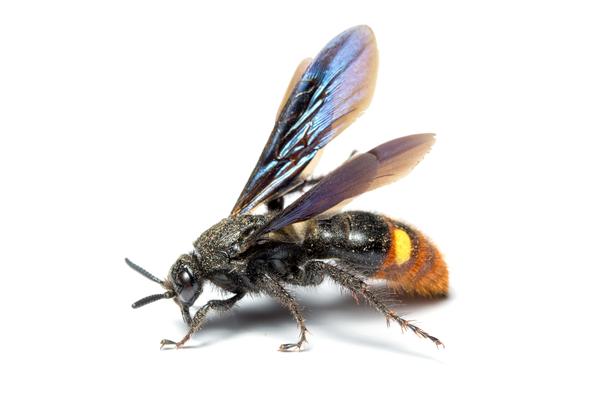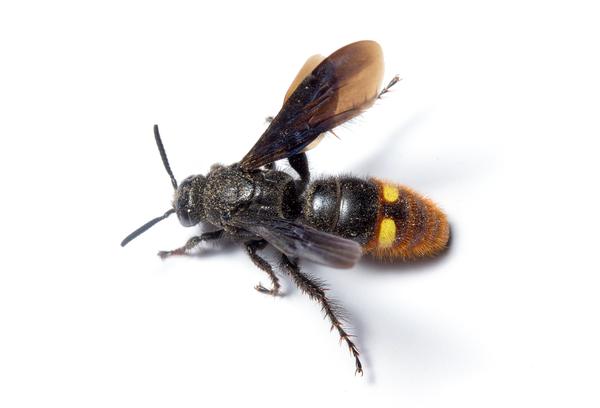Scoliid Wasps in Turf
en Español / em Português
El inglés es el idioma de control de esta página. En la medida en que haya algún conflicto entre la traducción al inglés y la traducción, el inglés prevalece.
Al hacer clic en el enlace de traducción se activa un servicio de traducción gratuito para convertir la página al español. Al igual que con cualquier traducción por Internet, la conversión no es sensible al contexto y puede que no traduzca el texto en su significado original. NC State Extension no garantiza la exactitud del texto traducido. Por favor, tenga en cuenta que algunas aplicaciones y/o servicios pueden no funcionar como se espera cuando se traducen.
Português
Inglês é o idioma de controle desta página. Na medida que haja algum conflito entre o texto original em Inglês e a tradução, o Inglês prevalece.
Ao clicar no link de tradução, um serviço gratuito de tradução será ativado para converter a página para o Português. Como em qualquer tradução pela internet, a conversão não é sensivel ao contexto e pode não ocorrer a tradução para o significado orginal. O serviço de Extensão da Carolina do Norte (NC State Extension) não garante a exatidão do texto traduzido. Por favor, observe que algumas funções ou serviços podem não funcionar como esperado após a tradução.
English
English is the controlling language of this page. To the extent there is any conflict between the English text and the translation, English controls.
Clicking on the translation link activates a free translation service to convert the page to Spanish. As with any Internet translation, the conversion is not context-sensitive and may not translate the text to its original meaning. NC State Extension does not guarantee the accuracy of the translated text. Please note that some applications and/or services may not function as expected when translated.
Collapse ▲Description
Scoliid wasps are dark in color, often metallic, relatively large, robust, slightly hairy insects with light yellow spots or other markings (Figure 1). One of the most common Scoliid wasps in North Carolina is Scolia dubia. It is sometimes referred to as the blue-winged wasp. The adult is over one-half inch long with black antennae and a shiny black head, thorax, and fore abdomen. About midway along the abdomen are two yellow spots (one on each side) (Figure 2). These may appear as a band across the abdomen when the wasp is flying. The latter portion of the abdomen is brownish and somewhat fuzzy. The wings are dark blue.
Biology
Scoliid wasps are usually considered beneficial insects because they help control green June beetle and other grubs. Scoliid wasps are present in North Carolina from June to October. However, they are most abundant during August. The female wasp flies low across the soil in search of grubs. When it detects one, it digs through the soil burrowing its own tunnel or following one made by the grub. Once locating a grub, she stings it on the throat and paralyzes it. At first, the grub appears to be dead, but after a day or so it can feebly move its legs. Such paralyzed grubs can live for a considerable time. The female wasp then lays an egg transversely on the third segment of the grub. The paralyzed grub provides a fresh food supply for the wasp larva after it hatches from the egg. Once a grub has been stung, it never recovers.
Scoliid wasps are very important natural agents in the control of green June beetle grubs in the soil. Adult Scoliid wasps feed on nectar and pollen of flowers. They do not sting unless stepped on or carelessly handeled. In early August, the wasps often rest on flowers but at night they burrow into the soil. Scoliid wasps are often noticed flying just a few inches above lawns infested with grubs in a loose figure-eight pattern. Sometimes these wasps are quite abundant and conspicuous as they partiicipate in their mating flights. After mating, females spend more time digging for grubs and flying wasps are not as noticeable.
Cultural Control
Since there is no record of anyone having been stung by Scoliid wasps, no control measures seem needed. Their presence, however, means that grubs are present. Monitoring for a white grubs infestation may be appropriate. If grubs have been a problem, see White Grubs in Turf.
Chemical Control for Green June Beetle Grubs
| Insecticide and Formulation | Amount per 1,000 sq ft |
|---|---|
| carbaryl* (Sevin) 80 WSP | 1.5 oz |
| pyrethroids* (Advanced Garden, Battle, Deltagard, Menace, Scimitar, Talstar, Tempo) | See label |
References
- Blue winged wasp, Scolia dubia—is a real asset! Sinclair, A. No Date. Penn State Extension.
- Digger Wasp. Anonymous. No Date. Department of Entomology Biological Control Information Center. NC State University
- 2018 Pest Control for Professional Turfgrass Managers. Bowman, D. et al. 2017. NC State Extension Publication AG-408. 81 pp.
- Extension Plant Pathology Publications and Factsheets
- Horticultural Science Publications
- North Carolina Agricultural Chemicals Manual
For assistance with a specific problem, contact your local Cooperative Extension Center




